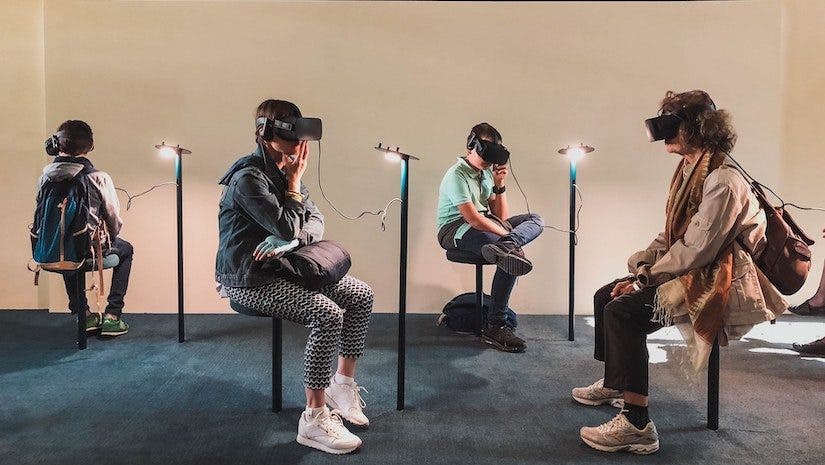The metaverse is the hottest topic to capture the tech industry’s interest as of late. In a recent and major announcement, Facebook CEO Mark Zuckerberg shared that his company would rebrand as Meta Platforms Inc., or simply Meta, signaling interest in pursuing the internet’s undetermined future.
The hypothesized metaverse currently doesn’t exist — at least not in the expansive way Zuckerberg might imagine it — but the footholds most certainly do. Virtual and augmented reality are the most essential components, with the former having risen in popularity thanks to Facebook’s acquisition of Oculus in 2014.
Zuckerberg appears to be going all-in, as he believes the metaverse will not only revolutionize the web as we know it, but also be a huge part of the digital economy. We’ve already witnessed a colossal surge of interest in crypto and non-fungible tokens (NFTs), and both are certain to merge into the metaverse.
The Meta Platforms CEO claims the internet’s future is still five to ten years away. However, with what we currently know, content creators can already begin to imagine how the metaverse will affect them.

What is the metaverse?
Writer Neal Stephenson coined the term “metaverse” in his 1992 novel Snow Crash. In the book, virtual avatars meet and interact in three-dimensional buildings and environments.
Since then, companies like Microsoft and Meta have taken strides to bring the metaverse into the real world. In the recent Facebook Connect keynote, Zuckerberg described the metaverse as a “virtual environment” users can actually enter and occupy. Instead of looking at the internet on your laptop screen, you can go inside of it.
It aims to be a place of intertwined virtual communities where people can meet, hang out, go shopping, work, watch concerts, attend sporting events, and more—all through a combination of virtual reality headsets, augmented reality glasses, and other devices.
The metaverse intends to be a doppelgänger world where people’s virtual lives operate the same way as their physical lives. To further elaborate, the hypothesized concept contains the following elements:
Public spaces where avatars interact
The most fundamental aspect of the proposed metaverse is a place in which people, represented by virtual avatars, can realistically navigate a virtual space. Think about how we’re represented by photo, video, or username on the web, social media, or in Zoom meetings.
In the metaverse, a 3D representation of ourselves can walk, talk, and interact with a virtual environment and other users. The avatar concept is nothing new, though recent advancements in virtual reality prove how in-depth an avatar can be.
VRChat, a popular virtual reality game, is a great example of how “characters” might interact in the metaverse. In the game, people assume the role of their avatar. They look through their eyes, use their hands, move around the environment, and of course, socialize with other users.
One “world” for users to exist in
Ideally, the metaverse would be a single world in which every users exists. This is akin to the notion that the metaverse could be a “doppelgänger universe,” where the virtual world closely resembles the real world. In the “one” metaverse, people could accumulate property and items like in real life, and their virtual existence would persist between sessions.
This could prove one of the hardest challenges for the idealized metaverse to overcome. In all that we’ve seen in games that loosely resemble what a metaverse might be, users inevitably end up split across different servers.
The ability to create, own, and exchange virtual property
Perhaps the most intriguing aspect of the proposed metaverse is in the creation, ownership, and exchange of virtual goods. This is something that will directly affect content creators who could seek additional revenue streams in the metaverse.
NFTs
As of now, non-fungible tokens (NFTs) have exploded. NFTs are unique digital assets which are minted and stored on the blockchain. They are decentralized and independent of any controlling body. When someone buys an NFT, they are designated as the owner of that asset. These assets can be freely traded. Digital art is currently the most popular form. Although, an NFT can be anything such as music, photos, video clips, or even website domain names.
This style of digital trading is unlikely to go away as the metaverse expands in coming years. It is very likely that NFTs will be the primary way to sell art and goods in the metaverse’s early stages — until, hypothetically, something else comes along.
While it’s still too early to speculate, there are some conceivable problems which may arise. Namely, it’s hard to say whether the freely tradable NFTs we know today will continue to be decentralized in the metaverse. Unfortunately, it seems unlikely that the idealized metaverse will exist as a single entity, but rather as a number of large metaverses run by different companies.
As these corporations begin to take an interest in what’s happening on their servers, for example, it remains unclear whether NFTs purchased in Microsoft’s metaverse will be transferable to Meta’s — at least not without some sort of financial penalty.

What does the metaverse mean for creators?
Ultimately, the metaverse will provide a new platform for photographers and creators to sell their work. The sheer novelty of this is sure to attract buyers, as “regular” NFTs have already done. Artists can mint their work, hang it in virtual galleries, and sell it to other people — all in the metaverse.
In fact, the world’s first version of this already exists. Legion Network, a pioneer in cryptocurrency and blockchain technology, announced that their Bluemoon NFT Marketplace is ready for launch.
Bluemoon is a collaborative NFT exchange with integrated virtual and augmented reality. Users will soon be able to browse virtual NFT galleries and interact with other buyers and sellers in one corner of what is sure to become the broader metaverse.
Bluemoon is incredibly innovative. Although, it’s unlikely to attract anyone still skeptical of cryptocurrency and NFTs. Creators who haven’t started to produce NFTs probably won’t feel pressured into jumping on that train just because of Bluemoon’s launch.
The metaverse could make NFTs universal
If Zuckerberg’s ambitions play out, the metaverse could become a part of everyone’s online presence. The possibility is that NFTs, as they exist in the metaverse, go mainstream and former skeptics are now potential buyers.
If that’s the case, then making art and content for the metaverse in any form —photography, videography, music, or otherwise — is sure to become viable revenue for creatives.
Conclusion
Inklings of the metaverse are already here. It has been witnessed in worlds like Fortnite where players have attended virtual concerts by Ariana Grande and Travis Scott. In Roblox, where players build homes and communities. We also see it in high fashion, where Burberry launched an NFT line for the game Blankos Block Party. In VRChat, where avatars can interact in virtual reality. And in Bluemoon, where people will soon be able to trade NFTs in virtual galleries.
Only time will tell if the metaverse can become a virtual parallel to our real lives. If it does, it will surely be another world for creators to share their work.






